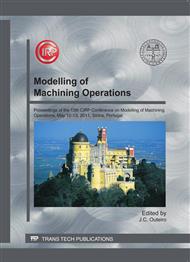p.733
p.743
p.754
p.764
p.774
p.784
p.794
p.804
p.813
Optimization of Process Parameters in CFRP Machining with Diamond Abrasive Cutters
Abstract:
The present paper proposes a methodology to optimize process parameters for trimming applications with diamond abrasive cutters. This methodology is based on the study of quality of trimmed surface, through material integrity and surface roughness, and on the study of cutting mechanisms. Their evolutions according to tool parameters and cutting conditions have been analysed. Results show that diamond grits size must be chosen according to the required surface roughness. Feedrate must respect cutting limitations due to CFRP removal mechanisms with abrasive cutters, which have been identify through analyses of specific cutting energy. Finally, a protocol in two steps is proposed to determine the optimum process parameters according to the application. Firstly, constraint functions due to respect of quality and to limiting cutting phenomena are defined. Thus, limiting values of process parameters are determined. Then, process parameters are selected in order to optimize productivity.
Info:
Periodical:
Pages:
774-783
Citation:
Online since:
April 2011
Authors:
Price:
Сopyright:
© 2011 Trans Tech Publications Ltd. All Rights Reserved
Share:
Citation:


